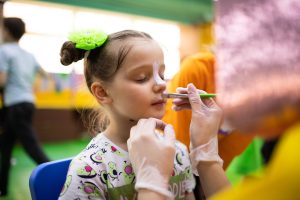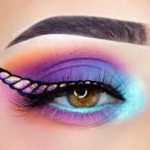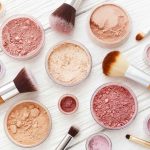Begin by discussing the ‘right’ age for kids to start experimenting with makeup, emphasizing parental guidance and the importance of makeup as a form of play rather than beautification. According to research from Tinybeans, it was suggested that most kids start showing interest in makeup between the ages of 12-15, but the actual decision should align with family values and discussions.
Today, we will look into some basic makeup that are suitable for kids. we will look into various types of products suitable for children. Such products includes lip gloss, eyeshadow, and more. Kids Beauty Expert lists various makeup items needed for the eye regions such as eyeshadow, eye pencil/liner, and eyebrow pencils, giving out the importance of using good products that avoid irritation.
- A World of Imagination: Begin by setting a whimsical tone, inviting readers into a world where makeup is a gateway to creativity, fun, and self-expression. Highlight the joy and excitement that makeup can bring to children, serving as a tool for imaginative play and artistic exploration.
- Emphasizing Safety and Simplicity: Stress the importance of using safe, non-toxic products specifically designed for sensitive skin. Mention that the focus will be on simple, easy-to-achieve looks that celebrate the innocence and beauty of childhood without overemphasis on adult concepts of beauty.
The Right Approach to Kids’ Makeup
- Choosing the Right Time: Discuss how parents can decide when their child is ready to explore makeup. Include insights on how makeup can be introduced as a part of dress-up play, emphasizing the playful aspect rather than appearance enhancement.
- Safety First: Offer guidance on selecting hypoallergenic, non-toxic makeup products suitable for children’s delicate skin. Mention brands or product types known for their safety standards.
Read Also: How to Apply Colorful Eye Makeup: A Rainbow Makeup Guide For Kids
Products and Tools for Simple Kids’ Makeup
- Kid-Friendly Makeup Essentials: List essential makeup items that are suitable for children, such as lip gloss, tinted moisturizer (instead of foundation), light eyeshadow, and water-based nail polish. Explain why each product is chosen and how it fits into a simple makeup routine.
- Tools of the Trade: Briefly describe the tools needed for applying kids’ makeup, emphasizing the importance of clean, soft brushes and sponges to prevent irritation.
Read Also: Beauty and the Werewolf Makeup Inspiration to Try Out

Step-by-Step Makeup Guide for Kids
Ensure a clear step-by-step guide to applying simple makeup. Try to focus on a look that brings the natural beauty of kids without overdoing it. Break down the process into easy-to-follow steps, such as preparing the skin, applying foundation and concealer lightly, and adding a touch of blush for a healthy glow, as described by Kids Beauty Expert.
- Preparation Is Key: Outline steps for preparing the skin, including cleansing and moisturizing with kid-friendly products.
- Foundation and Concealer: Discuss why these might be optional or replaced with a light, tinted moisturizer for a more natural look.
- Eyes on the Prize: Offer a guide to applying a simple eyeshadow look, perhaps a single, light color for a hint of sparkle. Include tips on safe application and removal.
- Cheeky Fun: Suggest adding a touch of blush for a rosy glow, explaining how to choose and apply blush to create a natural look.
- Lips and Finishing Touches: Describe how to apply lip gloss or balm for a bit of shine and hydration.
Read Also: Blush Children: 6 Reasons Why Kids Should Wear Blush When They Makeup
DIY Makeup Fun: Engaging Activities for Parents and Kids
- Homemade Lip Balm: Provide a simple recipe for making lip balm with natural ingredients like beeswax and coconut oil.
- Natural Face Paints: Share recipes for homemade, non-toxic face paints using ingredients such as cornstarch, face lotion, and natural food coloring.
- Crafting Your Makeup Tools: Suggest fun DIY projects, like decorating your makeup brush handles with stickers or washable paints, to personalize the makeup experience.
Educating Kids on Makeup: A Conversation Beyond Beauty
- Makeup as Art and Expression: Frame makeup as a form of artistic expression, rather than a necessity for looking “beautiful.” Encourage discussions about how makeup has been used historically in various cultures for different purposes, including theater, dance, and ceremonies.
- Healthy Beauty Habits: Teach children about the importance of skin care, emphasizing that makeup should be an occasional fun activity, not a daily necessity. Discuss the importance of removing makeup properly to keep skin healthy.
Read Also: 11 Best Vampire Makeup Ideas for 2024
-
Navigating Conversations About Makeup
Address the conversations parents might have with their kids about makeup. Discuss how these dialogues can be opportunities for teaching about self-expression, confidence, and the societal pressures related to appearance. Offer tips on how to keep these conversations positive and constructive, echoing the advice to ask meaningful questions and to discuss the intention behind wearing makeup.
Read Also: Blush Makeup Tutorial for Beginners
Conclusion: Celebrating Creativity, Safety, and Fun
- Summarizing Key Points: Reiterate the importance of safe, simple makeup practices for kids, emphasizing fun, creativity, and the opportunity for parent-child bonding.
- Encouraging Responsible Exploration: Conclude by encouraging parents to guide their children through the world of makeup with a focus on safety, health, and the joy of creative expression. Mention that makeup for kids should always be about enhancing the fun of dressing up and expressing themselves in imaginative ways.
Throughout the blog post, ensure to sprinkle humorous and engaging elements to keep the content light-hearted and enjoyable. For example, you could include funny anecdotes about makeup mishaps or playful challenges for parents and children to try together. Additionally, remember to place your keyword, “simple makeup for kids,” strategically throughout the post to optimize for search engines while maintaining a natural flow that resonates with your audience.
Given the extensive nature of the content required, this outline offers a robust framework for a blog post. Fleshing out each section with detailed information, personal anecdotes, and expert advice will help you reach the 3000-word count while providing valuable, engaging content for your readers.
Read Also: 5 Best Blush for Kids to Consider




[…] Read Also: How To Do A Simple Makeup For Kids […]
[…] Read Also: How To Do A Simple Makeup For Kids […]